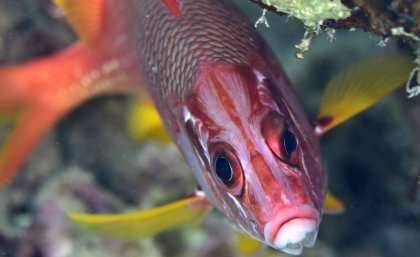Deep-sea vision linked to night life on the reef

To see—and survive—at night, some coral fish have developed visual adaptations that are similar to those of their cousins living in the ocean's darkest depths, new research shows.
University of Queensland researcher Dr. Fanny de Busserolles said the reef-dwelling squirrelfish and soldierfish had well-adapted visual systems for night-time activity.
"Like many nocturnal animals, their retinas have mainly rod cells," Dr. de Busserolles said.
"These are highly sensitive to the tiniest amount of light and are therefore used at night.
"However, our study found the squirrelfish and soldierfish also have an exceptionally high number of these sensitive cells stacked in layers, forming what is called a multibank retina.
"This type of visual adaptation is rarely found in the animal kingdom, except in deep-sea fishes.
"We were surprised to find it in shallow-living reef fishes."
Fish with multibank retinas often have between two and six rod banks, but the Queensland Brain Institute researchers found squirrelfish and soldierfish have many more—between six and 17.
Dr. de Busserolles said human and other vertebrates' retinas had two types of photoreceptor cells: cones and rods.
"Cones are used during the day and they help us determine colors," she said.
"Nocturnal animals like owls and cats have sacrificed cone cells in favor of rod-dominated eyes with a single layer of rod photoreceptors."
She said the advantage of a multibank retina was not clear, but scientists speculated it might increase sensitivity or enable fish to see color in the dark.
Co-author Dr. Fabio Cortesi said squirrelfish and soldierfish were Holocentridae, "a really interesting" family.
"Our results suggest they have the potential to discriminate colors in a wide range of light settings—during the day with their cones, and in dimmer conditions with their multibank retinas," Dr. Cortesi said.
"It is exciting that we in Queensland have an entire family of coral reef fish that can easily be studied in the aquarium," Dr. de Busserolles said.
"This study, along with additional experiments being run by the team, opens new avenues of research on the function of multibank retinas and the ability to see colors in the dark."
Dr. de Busserolles said the reef fishes' retinas also gave indications of activity during the day.
"When the sun rises, holocentrids usually retreat to the reef's dark corners, however we showed that the family may also have good daytime vision, having the potential to see color through their green and blue-sensitive cone cells," she said.
"Reef fishes that are active during the day grab plenty of attention because people are amazed by their brilliant colors.
"But this is an exciting discovery from some of their less colorful, nocturnal counterparts."
The researchers work in the lab of Professor Justin Marshall.
The research is published in the Journal of Experimental Biology.
More information: Fanny de Busserolles et al. The visual ecology of Holocentridae, a nocturnal coral reef fish family with a deep-sea-like multibank retina, The Journal of Experimental Biology (2020). DOI: 10.1242/jeb.233098
Journal information: Journal of Experimental Biology
Provided by University of Queensland



















